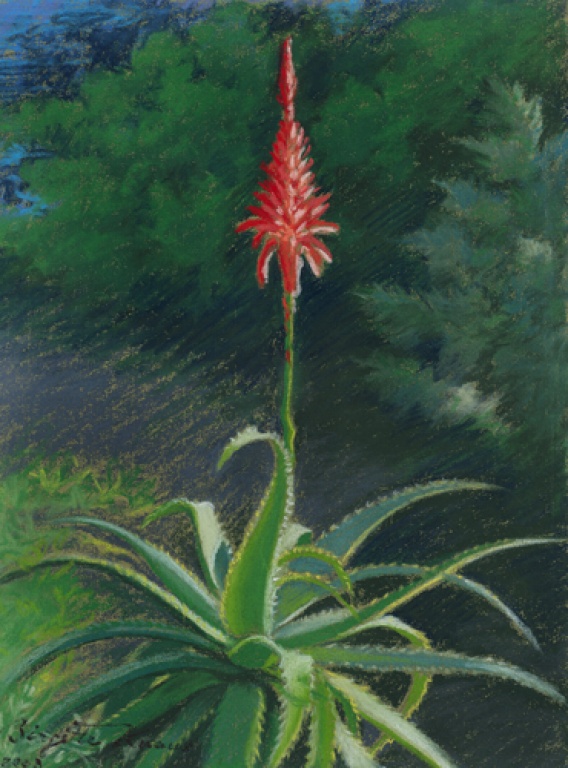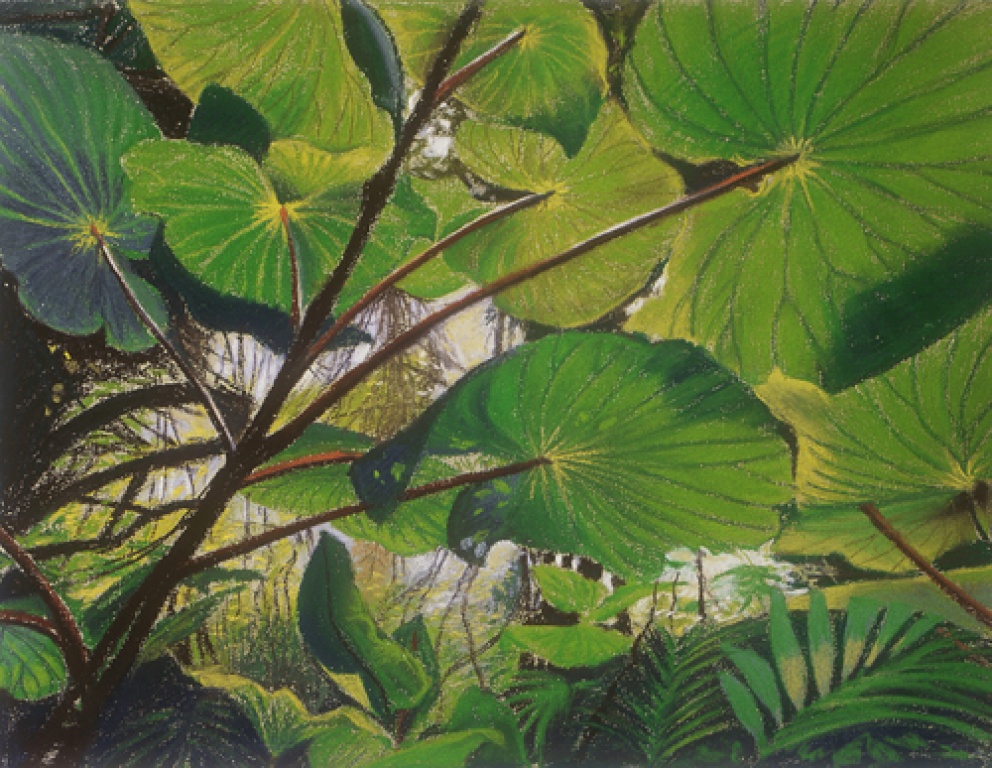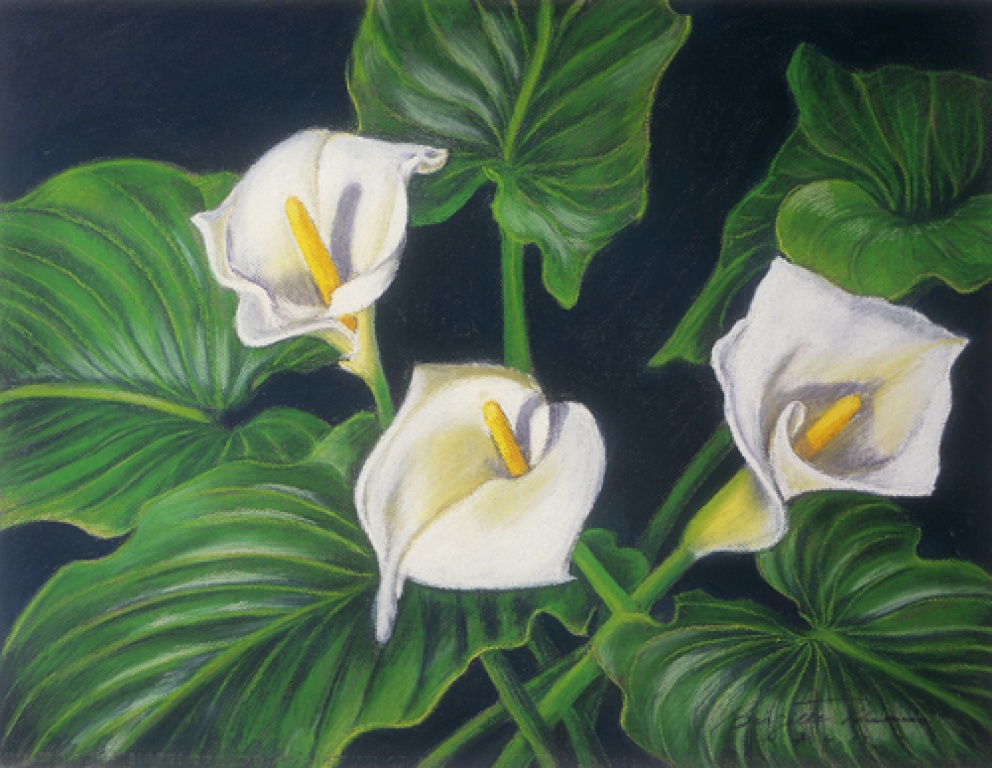Flower Portraits
Works of Art
Paintings in Pastel
Why flower portraits?
Flowers represent the essence of beauty in life. Nature creates flowers as the purest, most sublime and highest expression of art.
Just as with a good portrait, while painting my flower portraits, I found out I can capture and express the same life essence and personality as shown in my portraits, but this time capturing the essence and magic of a flower.
While painting a flower, I often have the feeling, as if they also observe me, while at the same time I feel there is a window opening and connecting me to another dimension.
2003
The secret life 0f flowers
Flowers and herbs of all shapes and beauty have circled the earth for over 200 million years. With a history like that, it is no wonder that we have an affinity for them. Apart from their beauty, flowers hold many medicinal properties as well as poignant meanings. (by Ian Campbell)
Each flower we observe has a specific beauty, a particular pallet of colors, shape and form. One gets a sense of absolute perfection, harmony and time-less beauty. I get the feeling as if they have been designed for a particular reason. Not by chance they vary depending on the climate, latitude and longitude, they vary from country to country, from continent to continent, but also from the northern or southern hemisphere of the planet where they grow.
Their brilliant colors and sometimes exotic shapes and forms attract our attention to come closer to them, to admire their beauty, to observe and smell the perfume they freely offer us. Even from the distance they defuse their spell and fragrance towards us. Their attraction and beauty are almost etherical, transcendental, as if they are emissaries or even portals from a parallel world trying to tell us something. Once you look, observe and admire them for a little while, it is as if they speak to us, they offer some kind of a window to another dimension or an unknown world to us, from which you have the feeling you are being downloaded with some information or perhaps powerful healing energies. One´s rational mind can´t comprehend, but maybe our higher Self knows and understands it.
As we all know the famous Bach Flower Remedies can heal many emotional imbalances in us and are widely used all over the world.
I have a suspicion that the color, shape, form and size of each flower is a complex living structure, they mostly obey an orderly universal sacred geometry pattern, through which they express, emit, receive and transfer specific information.
Some of them are really intriguing, such as the Passionflower. They have a variety of layers, a formation of different layers, as if it is kind of an organic architecture, like a very specific biological and living machinery linked to a cosmic computer in nature. They have many different components, such as what looks like all sorts of antennas and satellite dishes, which move up and down and in all direction during the day.
Another such interesting family of flowers are the orchids. When one observes them closely, you will find out that they look like small E.T´s incarnated on earth as flowers and have a significant role to play in all this complex system.
Apart of the flower´s reproduction system, such as creating pollen to attract bees to start the pollination process, they also seem to serve a multi-purpose function.
That is what fascinated me to start to paint them, to communicate with them and maybe understand them better.
As a professional portrait painter, having the facility to sense and express a more transcendental aspect of people´s personality or let´s say the soul of the person, I soon realized that painting a flower, it was almost the same experience for me. While I paint them, I feel and communicate on a soul level with them, to be able to express they inner soul and message through my paintings.
I wish you can also sense it by observing them and hopefully they transmit you the same healing energies and sublime experience.
Birgitte Knaus
This first chapter of Edgar Tolle´s book describes perfectly what I felt and experienced while painting the series of “Flower Portraits”.
Extract from “A NEW EARTH” by Edgar Tolle – Chapter One
The Flowering of Human Consciousness
Earth 114 million years ago, one morning just after sunrise:
The first flower ever to appear on the planet opens up to receive the rays of the sun. Prior to this momentous event that heralds an evolutionary transformation in the life of plants, the planet had already been covered in vegetation for millions of years. The first flower probably did not survive for long, and flowers must have remained a rare and isolated phenomena, since conditions were most likely not yet favorable for a widespread flowering to occur. One day, however, a critical threshold was reached, and suddenly there would have been an explosion of color and scent all over the planet – if perceived consciousness had been here to witness it.
Much later, those delicate and fragrant beings we call flowers would come to play an essential part in the evolution of consciousness of another species. Humans would increasingly be drown to and fascinated by them. As the consciousness of human beings developed, flowers were most likely the first thing they came to value that had no utilitarian purpose for them, that is to say, was not linked in some way to survival. They provided inspiration to countless artists, poets, and mystics. Jesus tells us to contemplate the flowers and learn from them how to live. The Buddha is said to have given a “silent sermon” once during which he held up a flower and gazed at it. After a while, one of those present, a monk called Mahakasyapa, began to smile. He is said to have been the only one who had understood the sermon. According to legend, that smile (that to say, realization) was handed down by twenty-eight successive masters and much later became the origin of Zen.
Seeing beauty in a flower could awaken humans, however briefly, to the beauty that is an essential part of their own innermost being, their true nature. The first recognition of beauty was one of the most significant events in the evolution of human consciousness. The feelings of joy and love are intrinsically connected to that recognition. Without our fully realizing it, flowers would become for us and expression in form of that which is most high, most sacred, and ultimately formless within ourselves. Flowers, more fleeting, more ethereal, and more delicate than plants out of which they emerged, would become like messengers from another realm, like a bridge between the would of physical forms and the formless. They not only had a scent that was delicate and pleasing to humans, but also brought a fragrance from the realm of spirit. Using the word “enlightenment” in wider sense than the conventionally accepted one, we could look upon flowers as the enlightenment of plants.
Any life-form in any realm – mineral, vegetable, animal, or human – can be said to undergo “enlightenment”. It is, however, an extremely rare occurrence since it is more than an evolutionary progression: It also implies a discontinuity in its development, a leap to an entirely different level of Being and, most important, a lessening of materiality.
What could be heavier and more impenetrable than a rock, the densest of all forms? And yet some rocks undergo a change in their molecular structure, turn into crystals, and so become transparent to the light. Some carbons, under inconceivable heat and pressure, turn into diamonds, and some heavy minerals into other precious stones.
Most crawling reptilians, the most earthbound of all creatures, have remained unchanged for millions of years. Some, however, grew feathers and wings and turned into birds, thus defying the force of gravity that had held them for so long. They didn´t become better at crawling or walking, but transcended crawling and walking entirely.
Since time immemorial, flowers, crystals, precious stones and birds have held significance for the human spirit. Like all life-forms they are, of course, temporary manifestations of the underlying one Life, one Consciousness. They special significance and the reason why humans feel such fascination for and affinity with them can be attributed to their ethereal quality.
Once there is a certain degree of Presence, of still and alert attention in human beings perceptions, they can sense the divine life essence, the one indwelling consciousness or spirit in eerie creature, every life-form, recognize it as one with their own essence and so love is as themselves. Until this happens, however, most humans see only the outer forms, unaware of the inner essence, just as they are unaware of their own essence and identify only with their own physical and psychological form.
In the case of a flower, a crystal, precious stone, or bird, however, even someone with little of no Presence can occasionally sense that there is more there than the mere physical existence of that form, without knowing that this is the reason why he or she is drawn toward it, feels an affinity with it. Because of its ethereal nature, its form obscures the indwelling spirit to a lesser degree that is the case with other life-forms. The exception to this are all new-born life-forms – babies, puppies, kittens, lambs, and so on. They are fragile, delicate, not yet firmly established in materiality. An innocence, a sweetness and beauty that are not of this world still shine through them. They delight even relatively insensitive humans.
So when you are alert and contemplate a flower, crystal, or bird without naming it mentally, it becomes a window for you into the formless. There is an inner opening, however slight, into the realm of spirit. This is why these three “en-lightened” life-forms have played such an important part in the evolution o human consciousness since ancient times;why, for example, the jewel in the lotus flower is a central symbol of Buddhism and a white bird, the dove, signifies the Holy Spirit in Christianity. They have been preparing the ground for a more profound shift in planetary consciousness that is designed to take place in the human species. This is the spiritual awakening that we are beginning to witness now.
Edgar Tolle


























